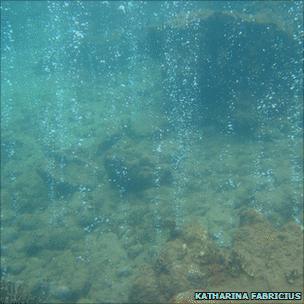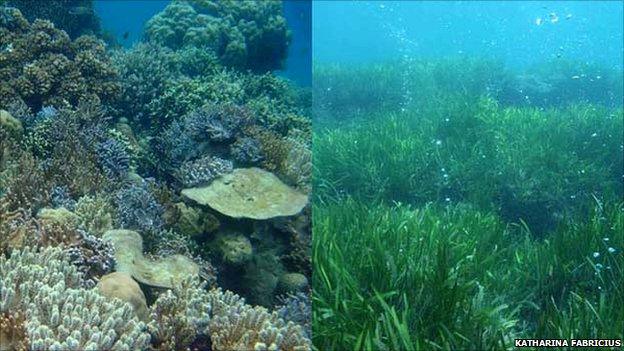Bubbling sea signals severe coral damage this century
- Published

This area is on the slope of a dormant volcano, and CO2 emerges from the seafloor naturally
Findings from a "natural laboratory" in seas off Papua New Guinea suggest that acidifying oceans will severely hit coral reefs by the end of the century.
Carbon dioxide bubbles into the water from the slopes of a dormant volcano here, making it slightly more acidic.
Coral is badly affected, not growing at all in the most CO2-rich zone.
Writing in journal Nature Climate Change, external, the scientists say this "lab" mimics conditions that will be widespread if CO2 emissions continue.
The oceans absorb some of the carbon dioxide that human activities are putting into the atmosphere.
This is turning seawater around the world slightly more acidic - or slightly less alkaline.
This reduces the capacity of corals and other marine animals to form hard structures such as shells.
Projections of rising greenhouse gas emissions suggest the process will go further, and accelerate.
"This is the most realistic experiment done to date on this issue," said Chris Langdon, a coral specialist from the Rosenstiel School of Marine and Atmospheric Science in Miami, US.
"So I don't have any qualms about believing that what we found will apply in other parts of the world."

Coral gives way to seagrass around the vents - the shape of things to come?
The water becomes progressively more acidic closer to the vents that are bubbling CO2.
This allows the researchers to study the impacts on coral at different levels of acidity.
Seawater has an average pH of about 8.1; this is already about 0.1 lower than before the industrial age and the large-scale human emissions of greenhouse gases associated with it.
The Intergovernmental Panel on Climate Change (IPCC) projects that by the end of the century, emissions may have risen so much that pH may fall to 7.8.
In the Papua New Guinea site, few types of coral grew at pH7.8.
Reefs still formed, but were dominated by one particular type, the Porites, which form massive shapes largely devoid of the branches and fronds that characterise reefs rich in species.
"We saw only a few speces of coral, and none of the structually complex ones that provide a lot of cover for fish," Professor Langdon told BBC News..
"The much simpler forms support many fewer species, and theory suggests they create an environment that would be very vulnerable to other stresses."
In an even more acid part of the study site, with a pH of 7.7, the scientists report that "reef development ceased".
Here, seagrasses dominate the floor - but they lack the hard-shelled snails that normally live on their fronds.
This is the second published study of a "natural lab" for ocean acidification.
The first, from a site in Mediterranean, found snails with their shells disintegrating; but the PNG site offers a snapshot of the future that might be more applicable to the world's tropical coral hotspots.
"The results are complex, but their implications chilling," commented Alex Rogers from the University of Oxford, who was not part of the study team.
"Some may see this as a comforting study in that coral cover is maintained, but this is a false perception; the levels of seawater pH associated with a 4C warming completely change the face of reefs.
"We will see the collapse of many reefs long before the end of the century."
The scientific team behind the new research, drawn from Australia, Germany and the US, suggests that the picture from PNG may underplay the threat.
Reefs in the acidic zones of the study site receive regular doses of larvae floating in from nearby healthy corals, replenishing damaged stocks.
This would not be the case if low pH levels pertained throughout the oceans.
In addition, corals at the site are only minimally affected by other threats; there is little fishing, local pollution, or disease.
By contrast, a major survey published earlier this year, external found that three-quarters of the world's reefs were at risk - 95% in southeast Asia - with exploitative and destructive fishing being the biggest immediate threat.
- Published23 February 2011